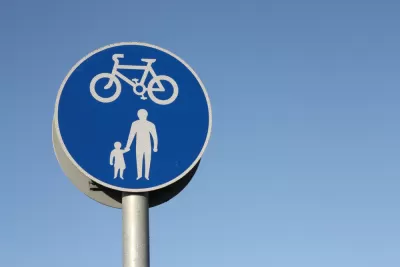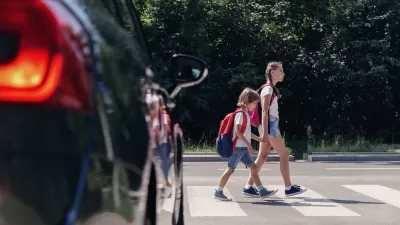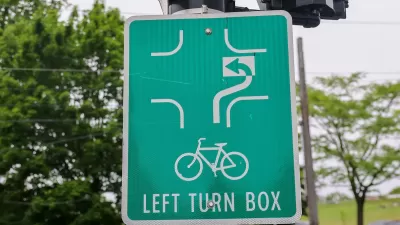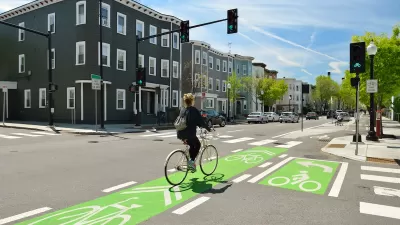One writer argues that rules that prioritize driver safety and ignore pedestrian infrastructure have led to a sharp increase in fatalities on U.S. roads.

Despite the COVID-induced reduction in miles driven in 2020, the number of people killed in vehicle crashes rose by 8% over 2019, with 42,000 people dying on U.S. roads, according to the National Safety Council. Calculated on a per-mile basis, writes Sara Bronin in Bloomberg CityLab, this amounts to a 24% increase in deaths—"the highest year-over-year jump in 96 years."
According to Bronin, "outdated, industry-written laws lock in street designs that encourage excessive speed, and we drive vehicles known to be deadly to non-drivers." While distracted driving and the rise of smartphones plays a small role, other countries have managed to keep their fatalities low. "Compare us with Germany, for example, where a love for speed and widespread cellphone use has not resulted in the death rates we see in the U.S. German traffic deaths fell 12% in 2020, which tracks the country’s 11% decrease in traffic volume."
Bronin writes that this is largely due to the fact that U.S. road design rules prioritize speed. The "Green Book," an influential design manual used widely across federal, state, and local governments, is "written without public input by traffic engineers at the American Association of State Highway and Transportation Officials (AASHTO)." The manual, according to Bronin, "requires lanes that are too wide, which encourages cars to drive faster, and practically ignores pedestrians and bikers. "
Fire codes requiring 20-foot wide unobstructed paths also dominate street design. Additionally, the Manual of Uniform Traffic Control Devices (MUTCD) "recommends setting speed limits that match the 85th percentile of actual free-flowing traffic, rounded up to the nearest 5 miles per hour. In effect, drivers breaking the law by speeding justifies raising speed limits even more."
Lastly, "U.S. safety regulators prioritize the people inside the vehicle, largely ignoring the non-passenger impact of passenger vehicles." Oversized vehicles with "huge frontal surfaces and poor forward vision" which would fail to meet European standards prove more dangerous to pedestrians and other drivers.
Reversing these trends, writes Bronin, calls for changing our regulatory culture. Her proposals for improving design rules include "diversify[ing] the people who codify road design," taking lessons from Complete Streets and other existing programs designed to slow traffic and improve pedestrian safety, increasing public input to design manuals, and prioritizing non-driver safety in the design of roads and vehicles.
FULL STORY: The Rules That Made U.S. Roads So Deadly

Alabama: Trump Terminates Settlements for Black Communities Harmed By Raw Sewage
Trump deemed the landmark civil rights agreement “illegal DEI and environmental justice policy.”

Planetizen Federal Action Tracker
A weekly monitor of how Trump’s orders and actions are impacting planners and planning in America.

The 120 Year Old Tiny Home Villages That Sheltered San Francisco’s Earthquake Refugees
More than a century ago, San Francisco mobilized to house thousands of residents displaced by the 1906 earthquake. Could their strategy offer a model for the present?

LA’s Tree Emergency Goes Beyond Vandalism
After a vandal destroyed dozens of downtown LA trees, Mayor Karen Bass vowed to replace them. Days later, she slashed the city’s tree budget.

Sacramento Leads Nation With Bus-Mounted Bike Lane Enforcement Cameras
The city is the first to use its bus-mounted traffic enforcement system to cite drivers who park or drive in bike lanes.

Seattle Voters Approve Social Housing Referendum
Voters approved a corporate tax to fund the city’s housing authority despite an opposition campaign funded by Amazon and Microsoft.
Urban Design for Planners 1: Software Tools
This six-course series explores essential urban design concepts using open source software and equips planners with the tools they need to participate fully in the urban design process.
Planning for Universal Design
Learn the tools for implementing Universal Design in planning regulations.
Ada County Highway District
Clanton & Associates, Inc.
Jessamine County Fiscal Court
Institute for Housing and Urban Development Studies (IHS)
City of Grandview
Harvard GSD Executive Education
Toledo-Lucas County Plan Commissions
Salt Lake City
NYU Wagner Graduate School of Public Service





























